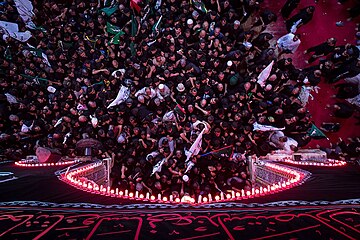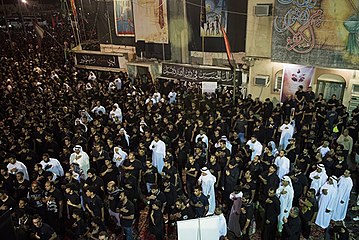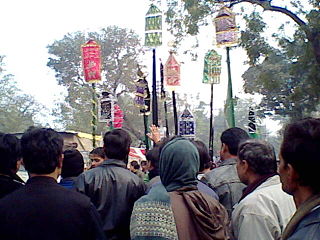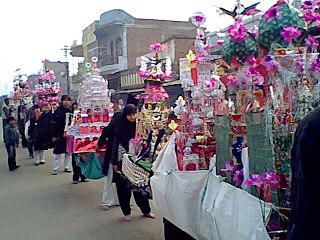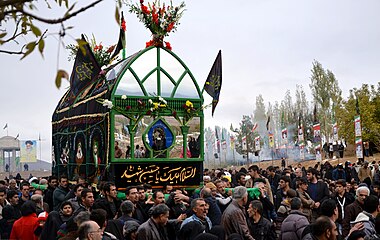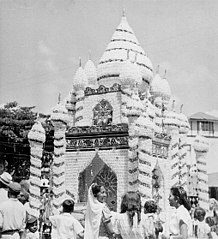Ashura
| Ashura عَاشُورَاء | |
|---|---|
 Ta'zieh in Bangladesh | |
| Also called | Youm-e Ashur |
| Type | Islamic (Shia and Sunni) |
| Significance | In Shia Islam: Mourning the death of Husayn ibn Ali, grandson of the Islamic prophet Muhammad and the third Shia imam In Sunni Islam: Commemorating God's parting of the Red Sea and his salvation of Moses and the Israelites from their slavery under the pharaoh |
| Observances | In Shia Islam: Mourning rituals Giving of food to the poor In Sunni Islam: Fasting |
| Date | 10 Muharram |
| 2024 date | 17 July[1] |
| 2025 date | 7 July |
| Frequency | Annual (Islamic calendar) |
| Part of a series on |
| Musa |
|---|
|
|
| Part of a series on |
| Husayn |
|---|
Ashura (Arabic: عَاشُورَاء, ʿĀshūrāʾ, [ʕaːʃuːˈraːʔ]) is a day of commemoration in Islam. It occurs annually on the tenth of Muharram, the first month of the Islamic calendar. For Sunni Muslims, Ashura marks the parting of the Red Sea by Moses and the salvation of the Israelites. Also on this day, Nuh disembarked from the Ark, God forgave Adam, and Joseph was released from prison, among various other auspicious events having occurred on Ashura according to Sunni tradition. Ashura is celebrated in Sunni Islam through supererogatory fasting and other acceptable expressions of joy. In some Sunni communities, the annual Ashura festivities include carnivals, bonfires, and special dishes, even though some Sunni scholars have criticized such practices.
By contrast, for Shia Muslims, Ashura is a day of mourning as they annually commemorate the death of Husayn ibn Ali, grandson of the Islamic prophet Muhammad and the third Shia imam. Husayn refused on moral grounds to pledge his allegiance to the Umayyad caliph Yazid ibn Mu'awiya (r. 680–683) and was subsequently killed, alongside most of his male relatives and his small retinue, by the Umayyad army in the Battle of Karbala on Ashura 61 AH (680 CE). Among the Shia, mourning for Husayn is viewed as an act of protest against oppression, a struggle for God, and a means of securing the intercession of Husayn in the afterlife. Ashura is observed through mourning gatherings, processions, and dramatic reenactments. In such ceremonies, Shia mourners strike their chests to share in the pain of Husayn. Extreme self-flagellation, often involving self-inflicted bloodshed, remains controversial among the Shia, condemned by many Shia clerics, and outlawed in some Shia communities. Ashura has sometimes been an occasion for sectarian violence, particularly against the Shia minority.
Etymology
[edit]Ashura is an Aramaic word meaning 'tenth'.[2] It may have also been derived from the Syriac words asiroya or asora.[3] It shares the same root as the Hebrew word 'āsōr.[4] In Arabic, Ashura refers to the tenth day of Muharram, the first month of the Islamic calendar, a month in which fighting has been forbidden since before the advent of Islam.[3][5]
Likely origins
[edit]Fasting on Ashura was likely a Jewish practice adopted by the Islamic prophet Muhammad after his arrival in the city of Medina in 622 CE,[4] perhaps signifying Muhammad's sense of a shared prophetic mission with Moses.[6] Although it remained optional, fasting on Ashura ceased to be a religious obligation after about a year when the relations with the Medinan Jews deteriorated.[4][7] This transition is often associated with verses 2:183–5 of the Quran, the central religious text in Islam, which explicitly designate Ramadan as the month of fasting.[2] It also seems improbable that Ashura initially coincided with the tenth of Muharram.[4][6] Instead, Ashura was probably observed at first on the tenth of the first Jewish month of Tishrei, known as Yom Kippur (lit. 'day of atonement').[6][8] The association of Ashura with the tenth of Muharram thus happened later, some time after the Jewish and Muslim calendars diverged.[4][6] In turn, the calendars began to diverge when Muhammad forbade Jewish-type calendar adjustments in connection with verse 9:37 of the Quran.[6][9][5]
In Sunni Islam
[edit]A similar origin story for Ashura appears in some Sunni traditions.[2] Alternatively, there are traditions in canonical Sunni collections that describe fasting on Ashura as a pre-Islamic practice among the Quraysh tribe, in which Muhammad also partook while he was in Mecca.[2] Some early Sunni traditions, many classified as unreliable,[10] possibly invented by the Umayyads (r. 661–750),[11] link Ashura to various auspicious events: On this day, Moses parted the Red Sea,[9][10] Noah disembarked from the Ark,[10] God forgave Adam, Joseph was released from prison, Jesus, Abraham, and Adam were born, Muhammad was conceived,[2] and Jonah was freed from the fish that had swallowed him.[12] Fasting on the ninth of Muharram, known as Tasu'a, was a later addition, probably to distinguish Muslims from Jews.[4][2]
Customs
[edit]In Sunni Islam, ninth and tenth of Muharram are days for voluntary fasting, strongly encouraged by Sunni jurists.[2] While not endorsed by all Sunni scholars,[2][13] Ashura is further viewed as a day of thanksgiving (shukr) to God, a joyous occasion, celebrated through pious acts and acceptable expressions of delight.[14] Ashura is thus an important festival for many Sunnis, in contrast to the Shia, who mourn on this day the slaughter of Muhammad's grandson, Husayn ibn Ali, and his small retinue in the Battle of Karbala in 680.[2] Such Sunni festivities either developed in response to Shia customs on Ashura or with the influence of pre-Islamic traditions.[15][2] In line with the former view, under the Umayyad caliph Abd al-Malik ibn Marwan (r. 685–705), Ashura was celebrated as a festive public holiday to counter the commemoration of Husayn.[16] The Abbasid caliph al-Qadir (r. 991–1031) did so too in Baghdad, Iraq.[17] Another instance is the reenactment by a Sunni mob of the Battle of the Camel (656) against Ali ibn Abi Talib, the first Shia imam, in the Buyid-era Baghdad on Ashura 973.[18][19]
Whatever the case is for their origins, such festivities were firmly established by the time of the Sunni jurist Ibn Taymiyya (d. 1328), to whom a questioner wrote, observing that people are joyful on Ashura; they bathe, adorn themselves, shake hands with each other, and cook grains.[15] In the Maghreb, for instance, Ashura is celebrated today through fasting, almsgiving, honoring the dead, special dishes, jumping over bonfires, and carnivals.[4] Nevertheless, particularly in South Asia, some Sunnis participated in the Shia rituals on Ashura,[2] at least until modern times.[2] Sufis also commonly commemorated the death of Husayn, more so in the earlier times, despite its variance with the views of the Sunni elite.[20] For Sufis, rather than a tragedy, Ashura celebrates the eternal life of Husayn and his companions, who annihilated themselves in the Divine with their martyrdom.[21]
Ibn Taymiyya
[edit]In response to an inquiry about their legal basis, Ibn Taymiyya rejects both mourning and celebrating on Ashura because, he contends, neither was practiced by Muhammad. Ibn Taymiyya does, however, encourage fasting on Ashura to emulate Muhammad. The Islamicist M. Katz questions the judgment of Ibn Taymiyya for not taking into account the Sunni reports that Muhammad fasted to celebrate Ashura, suggesting that Ibn Taymiyya has stripped fasting of its higher meaning.[22]
In Shia Islam
[edit]Battle of Karbala
[edit]In Shia Islam, Ashura commemorates the death of Husayn ibn Ali, Muhammad's grandson and the third Shia imam.[20] Husayn was killed, alongside most of his male relatives and his small retinue, on 10 Muharram 61 AH (10 October 680) in the Battle of Karbala against the army of the Umayyad caliph Yazid ibn Mu'awiya (r. 680–683), having been surrounded for some days and deprived of the drinking water of the nearby Euphrates river. After the battle, the women and children in Husayn's camp were taken prisoner and marched to the capital Damascus in Syria. The battle followed failed negotiations and Husayn's refusal to pledge his allegiance to Yazid, who is often portrayed by Muslim historians as impious and immoral.[23][24][25] The fight took place in the desert land of Karbala, en route to the nearby Kufa, whose residents had invited Husayn to lead them against Yazid.[26]
Significance
[edit]
Ashura is a day of mourning and grief for Shia Muslims.[20][27] It was observed as such by their imams,[28][29][30] who also frequently encouraged the Shia community to follow suit.[31] For instance, a tradition attributed to the Shia imam Ali al-Rida (d. 818) describes Ashura as a day of grieving and somber resignation from material affairs.[32] Shia tradition also dismisses as fabricated those Sunni hadiths that mark Ashura as a joyful occasion.[33] Indeed, traditions attributed to the Shia imams forbid fasting on this day,[34] and promise eternal punishment for those who celebrate Ashura as a day of blessing.[34][35]
In Shia Islam, Karbala symbolizes the eternal struggle between good and evil,[36][37] the pinnacle of self-sacrifice,[38] and the ultimate sabotage of Muhammad's prophetic mission.[11] Historically, the event served to crystallize the Shia community into a distinct sect and remains an integral part of their religious identity to date.[39][40] On the one hand, mourners share in the pain of Husayn and hope to benefit from his intercession on the Day of Judgement.[41][42] On the other, they view mourning for Husayn as an act of protest against oppression, a struggle for God (jihad), and as such an act of worship.[43][44]
Rituals
[edit]
In addition to pilgrimage to the shrine of Husayn, located in Karbala, Iraq,[45] Shia Muslims annually commemorate the events of Karbala throughout the months of Muharram and Safar.[40] Most rituals take place during the first ten days of Muharram, culminating on Ashura with processions in major Shia cities.[30][46] The main component of ritual ceremonies (majalis, sg. majlis) is the narration of the stories of Karbala (rawza-khwani, qiraya),[47][30][27] and the recitation of elegies and dirges (nawha, niyaha, marsia-khwani),[48][49] all intended to raise the sympathy of audience and move them to tears.[50][51] A majlis often takes place in a dedicated building or structure, known variously as Husayniya, takiya, imambarah, or azakhana.[48][52] Another component of mourning gatherings is the self-flagellation of participants to the rhythm of Karbala elegies.[49] Rooted in ancient Arab practices,[28][53] mild forms of self-flagellation, that is, striking one's face and chest in grief (latm, sina-zani, matam),[49][48][54] are common today in Shia communities.[55] But there are also extreme forms of self-flagellation (tatbir, tiq-zani, qama-zani), in which the participants strike themselves, usually on the forehead or back, with knives, swords, or chains to which razor blades are attached.[55] Banned in Iran and the Shia communities of Lebanon since the mid-90s,[56] instrumental self-flagellation has been condemned by many Shia clerics,[57] and it remains an often controversial practice among the Shia.[48]
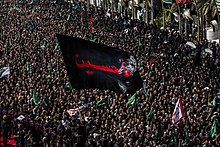
Another mourning ritual is the dramatic reenactment of Karbala narratives (ta'ziya, shabih-khwani), practiced today in Iran, in the western Gulf shore, and in Lebanon.[58] On Ashura, always the "martyrdom of Husayn" is reenacted in such performances.[58] In Karbala, an annual performance on Ashura reenacts the burning of Husayn's tents after the battle by the Umayyads and the captivity of the women and children.[59] During Muharram, especially on Ashura,[49] processions of mourners (dasta, mawkib) march the streets,[60] chanting dirges and elegies,[61] sometimes accompanied by self-flagellation.[49][59] For instance, in the tawarij march in Karbala, male and then female mourners walk barefoot to the shrine of Husayn in the afternoon of Ashura.[59] Depending on the region, processions carry symbolic objects, such as alam (lit. 'flag'),[62] nakhl (lit. 'date palm'),[63] ta'ziya,[63] and tadjah.[64] Alam represents the ensign of Husayn in Karbala,[63] while the last three objects symbolize his bier or tomb.[63][65]
Terrorist attacks during Ashura
[edit]Ashura has sometimes been an occasion for Sunni violence against Shia Muslims, who are often a minority in Muslim communities.[66] In India, for instance, the Sunni activist Ahmad Barelvi (d. 1831) preached against Ashura rituals and, probably with some exaggeration, boasted of destroying thousands of imambargahs, which are buildings dedicated to ritual mourning.[67] Some terrorist attacks against Ashura services are listed below.
- 1940: Bomb thrown at an Ashura procession, Delhi, India, 21 February.[68]
- 1994: Bomb explosion in the Imam Reza shrine, Mashhad, Iran, 20 June, 20 people killed.[69]
- 2004: Bomb explosions, Karbala and Najaf, Iraq, 2 March, over 180 Shia worshipers killed and 5000 injured.[70][71]
- 2008: Two separate attacks on Ashura processions, Iraq, 19 January, 9 people killed.[72]
- 2009: Bomb explosion in an Ashura procession, Karachi, Pakistan, 28 December, 43 people killed and 60 injured.[73]
- 2011: Multiple bomb explosions in Ashura processions, Central Iraq, 6 December, 30 people killed.[74]
- 2011: Two separate bomb explosions among Ashura mourners, Kabul, Afghanistan, 6 December, 80 people killed and 160 injured.[75][76]
- 2015: Bomb explosions in a mosque, Dhaka, Bangladesh, 24 October, one worshipper killed and 80 injured.[77]
In the Gregorian calendar
[edit]Ashura, tenth of Muharram in the Islamic calendar, corresponds to a different day every year in the Gregorian calendar.[78]
| Islamic calendar | 1447 | 1448 | 1449 |
|---|---|---|---|
| Gregorian calendar | 5 July 2025[79] | 25 June 2026[79] | 15 June 2027[79] |
Gallery
[edit]-
Tawarij march on Ashura, Karbala
-
Ashura procession in Syria
-
Shia mourners on Ashura in Saudi Arabia
-
Ashura procession in India carrying alams, signifying the ensign of Husayn in Karbala
-
Alam of an Ashura procession in Iran
-
In India, ta'ziya symbolizes Husayn's bier
-
In Iran, nakhl symbolizes Husayn's bier
-
Ashura reenactment of the burning of Husayn's tents, Iran
See also
[edit]Footnotes
[edit]- ^ "Ashura 2024: Dates in India, Saudi Arabia, UAE, US, UK, Iran, and other countries". timesnownews.com. 11 July 2024. Archived from the original on 19 July 2024.
- ^ a b c d e f g h i j k l Reid 2011.
- ^ a b Fakhr-Rohani 2014, p. 228.
- ^ a b c d e f g Wensinck & Marçais 2012.
- ^ a b Plessner 2012.
- ^ a b c d e Peters 1994, p. 204.
- ^ Dakake 2007, p. 112.
- ^ Ayoub 2005, p. 549.
- ^ a b Newman 2023.
- ^ a b c Katz 2007, p. 149.
- ^ a b Crow 2016.
- ^ Gordon Melton 2010, p. 210.
- ^ Katz 2007, pp. 115–116.
- ^ Katz 2007, pp. 64, 110.
- ^ a b Katz 2007, p. 113.
- ^ Hussain 2005, p. 82.
- ^ Rahimi 2012, p. 210.
- ^ Hussain 2005, p. 84.
- ^ Chelkowski 1985, p. 20.
- ^ a b c Aghaie 2013.
- ^ Hyder 2006, p. 10.
- ^ Katz 2007, pp. 116–117.
- ^ Momen 1985, p. 28.
- ^ Pinault 2000, p. 70.
- ^ Aghaie 2007, p. 117.
- ^ Madelung 2004.
- ^ a b Beverley 2011, p. 48.
- ^ a b Hussain 2005, p. 81.
- ^ Nakash 1993, p. 163.
- ^ a b c Osman 2014, p. 133.
- ^ Rahimi 2012, p. 205.
- ^ Ayoub 1978, pp. 150–151.
- ^ Ayoub 1978, p. 150.
- ^ a b Ayoub 1978, pp. 149, 151.
- ^ Nakash 1993, p. 166.
- ^ Aghaie 2004, p. 9.
- ^ Aghaie 2007, p. 112.
- ^ Chelkowski 1985, p. 19.
- ^ Kennedy 2016, p. 77.
- ^ a b Hyder 2006, p. 9.
- ^ Blank 2001, p. 84.
- ^ Munson 1988, p. 24.
- ^ Ayoub 1978, pp. 142–143.
- ^ Nakash 1993, p. 165.
- ^ Szanto 2018, p. 14.
- ^ Momen 1985, p. 240.
- ^ D'Souza 1998.
- ^ a b c d Calmard 1987.
- ^ a b c d e Hussain 2005, p. 79.
- ^ Pinault 2000, p. 77.
- ^ Chelkowski 2012b.
- ^ Campo 2009, p. 320.
- ^ Nakash 1993, p. 169.
- ^ Pinault 1992, p. 99.
- ^ a b Flaskerud 2015.
- ^ Szanto 2013, p. 75.
- ^ Calmard 2004.
- ^ a b Chelkowski 2012a.
- ^ a b c Szanto 2018, p. 12.
- ^ Chelkowski 1985, p. 27.
- ^ Ayoub 1978, p. 154.
- ^ Calmard & Allan 1985.
- ^ a b c d Chelkowski 1985, p. 24.
- ^ Korom & Chelkowski 1994, pp. 154–155.
- ^ Korom & Chelkowski 1994, pp. 152, 154–155.
- ^ Gordon Melton 2010.
- ^ Metcalf 2014, p. 58.
- ^ Hollister 1979, p. 178.
- ^ Raman, B. (7 January 2002). "Sipah-E-Sahaba Pakistan, Lashkar-e-Jhangvi, Bin Laden & Ramzi Yousef". Archived from the original on 29 April 2009.
- ^ "Blasts at Shia Ceremonies in Iraq Kill More Than 140". The New York Times. 2 March 2004. Retrieved 18 March 2017.
- ^ Hassner 2016, p. 145.
- ^ "Iraqi Shia pilgrims mark holy day". bbc.co.uk. 19 January 2008. Retrieved 10 October 2015.
- ^ "Pakistan Taliban says carried out Karachi bombing". Reuters. 30 December 2009. Retrieved 22 August 2023.
- ^ "Deadly bomb attacks on Shia pilgrims in Iraq". bbc.co.uk. 5 December 2011. Retrieved 30 June 2012.
- ^ Afghanistan's President Says Death Toll From Shrine Blast Has Risen to at Least 80, Fox News, 11 December 2011, retrieved 11 December 2011
- ^ Harooni, Mirwais (6 December 2011). "Blasts across Afghanistan target Shia, 59 dead". Reuters. Retrieved 30 June 2012.
- ^ "Dhaka blasts: One dead in attack on Shia Ashura ritual". BBC News. 24 October 2015. Retrieved 24 February 2016.
- ^ Gent, R.H. van. "The Umm al-Qura Calendar of Saudi Arabia". webspace.science.uu.nl.
- ^ a b c "Hijri to Gregorian Date Converter - Islamic Date Converter". IslamicFinder. Retrieved 10 August 2024.
References
[edit]- Aghaie, K.S. (2004). The Martyrs of Karbala: Shi'i Symbols and Rituals in Modern Iran. University of Washington Press. ISBN 0295984554.
- Aghaie, K.S. (2007). "The Passion of 'Ashura in Shiite Islam". In Cornell, V.J. (ed.). Voices of Islam. Vol. 2. Praeger. pp. 111–124. ISBN 978-0275987343.
- Aghaie, K.S. (2013). "'Āshūrā' (Shī'ism)". In Fleet, K.; Krämer, G.; Matringe, D.; Nawas, J.; Stewart, D.J. (eds.). Encyclopaedia of Islam (Third ed.). doi:10.1163/1573-3912_ei3_COM_23855. ISBN 9789004252684.
- Ayoub, M.M. (1978). Redemptive Suffering in Islam: A Study of the Devotional Aspects of Ashura in Twelver Shi'ism. De Gruyter. ISBN 9789027979438.
- Ayoub, M.M. (2005). "'Āshūrā'". In Jones, L. (ed.). Encyclopedia of Religion. Vol. 1 (Second ed.). MacMillan Reference USA. pp. 549–550. ISBN 0028657349.
- Berg, C.C. (2012). "Ṣawm". In Bearman, P.; Bianquis, Th.; Bosworth, C.E.; van Donzel, E.; Heinrichs, W.P. (eds.). Encyclopaedia of Islam (Second ed.). doi:10.1163/1573-3912_islam_COM_0068. ISBN 9789004161214.
- Beverley, J.A. (2011). "Ashura". In Gordon Melton, J. (ed.). Religious Celebrations: An Encyclopedia of Holidays, Festivals, Solemn Observances, and Spiritual Commemorations. ABC-CLIO. pp. 47–49. ISBN 9781598842050.
- Blank, J. (2001). Mullahs on the Mainframe: Islam and Modernity Among the Daudi Bohras. University of Chicago Press. ISBN 9780226056760.
- Calmard, J.; Allan, J.W. (1985). "'Alam va 'Alāmat". Encyclopaedia Iranica. Vol. I/8. pp. 785–791.
- Calmard, J. (1987). "'Azādārī". Encyclopaedia Iranica. Vol. III/2. pp. 174–177.
- Calmard, J. (2004). "Ḥosayn b. 'Ali ii. In Popular Shi'ism". Encyclopaedia Iranica. Vol. XII/5. pp. 498–502.
- Campo, J.E., ed. (2009). "Husayniyya". Encyclopedia of Islam. Facts on File. pp. 319–321. ISBN 9780816054541.
- Chelkowski, P (1985). "Shia Muslim Processional Performances". The Drama Review: TDR. 29/3 (3): 18–30. doi:10.2307/1145650. JSTOR 1145650.
- Chelkowski, P. (2012a). "Ta'ziya". In Bearman, P.; Bianquis, Th.; Bosworth, C.E.; van Donzel, E.; Heinrichs, W.P. (eds.). Encyclopaedia of Islam (Second ed.). doi:10.1163/1573-3912_islam_SIM_7476. ISBN 9789004161214.
- Chelkowski, P. (2012b). "Rawḍa-Ḵẖwānī". In Bearman, P.; Bianquis, Th.; Bosworth, C.E.; van Donzel, E.; Heinrichs, W.P. (eds.). Encyclopedia of Islam (Second ed.). doi:10.1163/1573-3912_islam_SIM_6256. ISBN 9789004161214.
- Crow, D.K. (2016). "The Death of al-Ḥusayn b. 'Alī and Early Shī'ī Views of the Imamate". In Kohlberg, E. (ed.). Shi'ism. Taylor & Francis. ISBN 9781351900287.
- Dakake, M.M. (2007). The Charismatic Community: Shi'ite Identity in Early Islam. State University of New York Press. ISBN 9780791470336.
- D'Souza, D. (1998). "The Figure of Zaynab in Shi'i Devotional Life". In Singh, D.E. (ed.). Spiritual Traditions: Essential Visions for Living. United Theological College. pp. 201–225. ISBN 9788172144616.
- Fakhr-Rohani, M.R. (2014). "Ashura". In Morrow, J.A. (ed.). Islamic Images and Ideas: Essays on Sacred Symbolism. McFarland & Company. pp. 228–250. ISBN 9780786458486.
- Flaskerud, I. (2015). "Flagellation". In Fleet, K.; Krämer, G.; Matringe, D.; Nawas, J.; Stewart, D.J. (eds.). Encyclopaedia of Islam (Third ed.). doi:10.1163/1573-3912_ei3_COM_27156. ISBN 9789004282117.
- Gordon Melton, J. (2010). "Ashura". In Gordon Melton, J.; Baumann, M. (eds.). Religions of the World: A Comprehensive Encyclopedia of Beliefs and Practices (Second ed.). ABC-CLIO. pp. 210–212. ISBN 9781598842043.
- Hassner, R.E. (2016). Religion on the Battlefield. Cornell University Press. ISBN 9780801451072.
- Hollister, J.N. (1979). The Shi'a of India (Second ed.). Oriental Books Reprint Corporation.
- Hussain, A.J. (2005). "The Mourning of History and the History of Mourning: The Evolution of Ritual Commemoration of the Battle of Karbala". Comparative Studies of South Asia, Africa and the Middle East. 25 (1): 78–88. doi:10.1215/1089201X-25-1-78. S2CID 143516655.
- Hyder, S.A. (2006). Reliving Karbala: Martyrdom in South Asian Memory. Oxford University Press. ISBN 9780195373028.
- Katz, M.H. (2007). The Birth of the Prophet Muḥammad: Devotional piety in Sunni Islam. Routledge. ISBN 9780203962145.
- Kennedy, H. (2016). The Prophet and the Age of the Caliphates: The Islamic Near East from the Sixth to the Eleventh Century (Third ed.). Routledge. ISBN 9781138787612.
- Korom, F.J.; Chelkowski, P. (1994). "Community Process and the Performance of Muharram Observances in Trinidad". The Drama Review. 38 (2): 150–75. doi:10.2307/1146338. JSTOR 1146338.
- Madelung, W. (2004). "Ḥosayn b. 'Ali i. Life and Significance in Shi'ism". Encyclopaedia Iranica. Vol. XII/5. pp. 493–498.
- Melton, J.G. (2010). "Ashura". In Melton, J.G.; Baumann, M. (eds.). Religions of the World: A Comprehensive Encyclopedia of Beliefs and Practices (Second ed.). ABC-CLIO. pp. 210–212. ISBN 9781598842043.
- Metcalf, B.D. (2014). Islamic Revival in British India: Deoband, 1860–1900. Princeton University Press. ISBN 9781400856107.
- Momen, M. (1985). An Introduction to Shi'i Islam. Yale University Press. ISBN 9780300035315.
- Munson, H. (1988). Islam and Revolution in the Middle East. Yale University Press. ISBN 0300046049.
- Nakash, Y. (1993). "An Attempt to Trace the Origin of the Rituals of 'Āshūrā'". Die Welt des Islams: 161–181. JSTOR 1570949.
- Newman, A.J. (28 December 2023). "'Āshūrā'". Encyclopedia Britannica.
- Osman, R. (2014). Female Personalities in the Qur'an and Sunna: Examining the Major Sources of Imami Shi'i Islam. Routledge. ISBN 9781315770147.
- Peters, F.E. (1994). Muhammad and the Origins of Islam. State University of New York Press. ISBN 0791418758.
- Pinault, D. (1992). The Shiites: Ritual and Popular Piety in a Muslim Community. St. Martin's Press. ISBN 0312079532.
- Pinault, D. (2000). "Zaynab bin 'Ali and the Place of the Women of the Households of the First Imāms in Shī'ite Devotional Literature". In Hambly, G. (ed.). Women in the Medieval Islamic World: Power, Patronage, and Piety. Macmillan. ISBN 9780333800355.
- Plessner, M. (2012). "al-Muḥarram". In Bearman, P.; Bianquis, Th.; Bosworth, C.E.; van Donzel, E.; Heinrichs, W.P. (eds.). Encyclopaedia of Islam (Second ed.). doi:10.1163/1573-3912_islam_SIM_5426. ISBN 9789004161214.
- Rahimi, B. (2012). "A History of (Safavid) Muharram Rituals". Theater State and the Formation of Early Modern Public Sphere in Iran: Studies on Safavid Muharram Rituals, 1590–1641 CE. Brill. pp. 199–234. doi:10.1163/9789004207561_006. ISBN 9789004209794.
- Reid, M.H. (2011). "'Āshūrā' (Sunnism)". In Fleet, K.; Krämer, G.; Matringe, D.; Nawas, J.; Stewart, D.J. (eds.). Encyclopaedia of Islam (Third ed.). doi:10.1163/1573-3912_ei3_COM_23081. ISBN 9789004203532.
- Szanto, E. (2013). "Beyond the Karbala Paradigm: Rethinking Revolution and Redemption in Twelver Shi'a Mourning Rituals". Journal of Shi'a Islamic Studies. 6 (1): 75–91. doi:10.1353/isl.2013.0007. S2CID 144319026.
- Szanto, E. (2018). "Shi'a Islam in Practice". In Woodward, M.; Lukens-Bull, R. (eds.). Handbook of Contemporary Islam and Muslim Lives. Springer. pp. 1–15. doi:10.1007/978-3-319-73653-2_8-2. ISBN 978-3-319-73653-2. S2CID 158107119.
- Wensinck, A.J.; Marçais, Ph. (2012). "'Ās̲h̲ūrā'". In Bearman, P.; Bianquis, Th.; Bosworth, C.E.; van Donzel, E.; Heinrichs, W.P. (eds.). Encyclopaedia of Islam (Second ed.). doi:10.1163/1573-3912_islam_COM_0068. ISBN 9789004161214.
Further reading
[edit]External links
[edit] Media related to Ashura at Wikimedia Commons
Media related to Ashura at Wikimedia Commons


